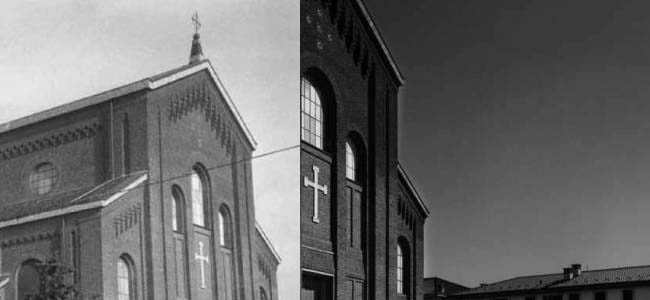 Built on the place of a sixteenth century building but of even more remote origins, the current church was completely rebuilt between 1937 and 1938 by the parish priest Don Benedetto Bonati; nothing remains of the ancient structure, but the current doesn't lack in artistic merits: the author of the impressive project is the Milanese architect Giovanni Maggi and inside are kept important frescos by Antonio Martinotti. Moreover, some furniture of the old church is still hosted here, like a statue of the Virgin and the Child of the seventeenth century and a eighteenth-century confessional.
Built on the place of a sixteenth century building but of even more remote origins, the current church was completely rebuilt between 1937 and 1938 by the parish priest Don Benedetto Bonati; nothing remains of the ancient structure, but the current doesn't lack in artistic merits: the author of the impressive project is the Milanese architect Giovanni Maggi and inside are kept important frescos by Antonio Martinotti. Moreover, some furniture of the old church is still hosted here, like a statue of the Virgin and the Child of the seventeenth century and a eighteenth-century confessional.
The most evident element remains anyway the largest red brick structure that dominates the centre of Albairate: at first glance it can seem a little valorous building, but if you insert it in the historical context in which it was created can be an interesting example of sacred architecture in the Fascist age: the architect Giovanni Maggi, in fact, is known above all for his design of the church of Saints Nereus and Achilleus in Milan, a church that, like this in Albairate has got a red brick structure and neo - Romanesque forms; however, the same architect has also designed the seat of the National Bank for Agriculture in Fontana Square in Milan, known for the attempt of 1969.
Giovanni Maggi, in fact, can not be inserted in a superficial way in the current of the late neo- Romanesque ecletticism, but should be regarded as an architect of the twentieth century style, as is evident from the imposing Milan bank, which better than others has been able to bend the austere architecture of the twentieth century to the Church needs strengthened by the Lateran Pacts. The recovery of the building Lombard tradition - the brick - and of medieval forms emphasize a desire of continuity and a renewed focus on the Church history that must be emphasized in order to recover a religion now pressed by the progress of modern society.
That's why, while the church of Saints Nereus and Achilleus takes again St. Ambrose Basilica, this in Albairate recalls the large rural parishes, with three naves, a transept and a terminal apse, a church fit for preaching with certainly neo-Romanesque forms - see the decorations on the facade, columns, vaults - but in the linearity and aridity is of the twentieth-century: the façade, in particular, is structured on regular sections, with arched windows and rectangular doors cut into the wall with no decorative elements. A choice of strict rationality that characterizes the buildings of the twentieth and here links to the necessary appeal to Christian history.
In this context also fit well the ciborium, which recalls St. Ambrose's one in Milan, and the frescoes by Antonio Martinotti, marked by a strong attraction to Beato Angelico's art and some early Christian suggestion: in practice, even in the great cycles of the frescoes made here there is the tradition continuity linked to the twentieth century austerity. On the whole, then, in Albairate after the stage to the baroque St. Bernard's church, you can stop to watch a modern building , which if you are careful may appear not lacking in quality.
- Street of Parco 27 - 20080, Albairate, MI, Italy
- Telefono: + 39 02 940 66 47
- E-mail: This email address is being protected from spambots. You need JavaScript enabled to view it.
 English (UK)
English (UK)  Italiano (Italia)
Italiano (Italia) 
